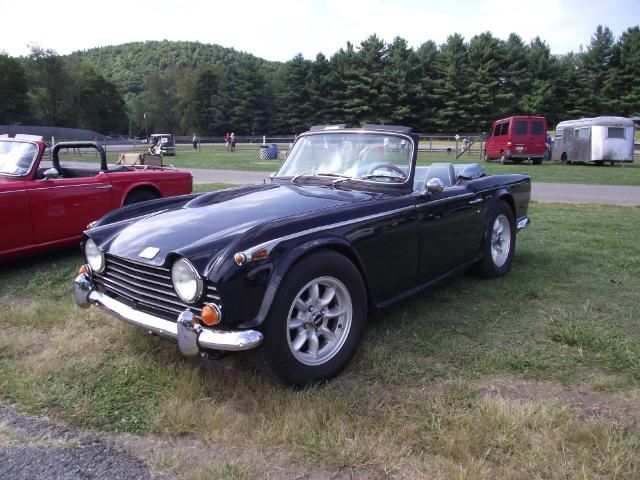Story by David S. Wallens and Tim Suddard.
Most all sports car enthusiasts know the Triumph TR6, the iconic sports car from the first half of the 1970s. It was a huge success on both the road and the track. Then there’s the TR4, the brand’s model that helped define the 1960s.
The one-year-only TR250, however, tends to get lost in the shuffle. It marries the Michelotti-designed TR4 body with the six-cylinder engine that makes the TR6 such a brute.
Is it the best of both worlds or a wayward blip in Triumph history?
Counting to Six

The Triumph TR6 might have contained a lot of hand-me-down parts, but it was a giant success for its maker. Today it’s still a great companion thanks to its torquey engine and nicely trimmed interior.
Up until the 1953 release of the TR2, the Triumph brand was associated with family cars and saloons, not sporting machines. While MG offered true sports cars both before and after the war, Triumph had no such animals in their lineup.
The TR1 show car, displayed at the 1952 London Motor Show, changed all that and gave birth to the TR2 production machine. Where the MG T-series still had cycle fenders and a prewar look, the Triumph was thoroughly modern.
Okay, so maybe the chassis, engine and suspension came from the brand’s production sedans, but the body was totally cutting edge: low-cut doors, bullet-shaped headlight housings, and flowing rear fenders that terminated in simple taillights. The TR2 immediately turned Triumph into one of the world’s most important sports car producers.
The quite similar TR3 replaced the TR2 for the 1955 model year. Triumph made minor tweaks, but the bulk of the car was a carry-over–even for the later, refined TR3A and TR3B iterations. Despite this sameness, the brand’s reputation only grew.
Something new and exciting appeared for 1961: the TR4. The boxier yet still soft body provided room for a real trunk plus windup windows. Underneath was another big upgrade: rack-and-pinion steering. The chassis and drivetrain, though, could be called carry-over items, all dating back a decade or two. Fans still ate up the new car.
If there was something close to a major update during the ’60s, it was the independent rear that coincided with the 1965 release of the TR4A. Plus, a revised frame was part of the new package. The rest of the car was made up of, you guessed it, carry-overs.
Big news was on the horizon for 1969, though, in the form of the TR6. The German design firm Karmann squared off the nose and tail to create a contemporary look, while more grunt came courtesy of the 2.5-liter, inline six-cylinder engine slipped under the hood. The Triumph sports car had moved upmarket–even though the rest of the car contained recycled items.
Sandwiched between the TR4A and the TR6, though, was a short-lived model that merged the classic TR4 body with the TR6’s six-cylinder engine. In the home market, it was called the TR5. Americans knew it as the TR250, and it was only available for the 1968 model year.
Two Sides of the Same Coin?
The British-market TR5 really was a game-changer, as the car’s inline-six received Lucas fuel injection. Total output was some 150 horsepower, 45 more than the outgoing TR4A.
American-spec examples didn’t receive the intake setup, though. Two tried and true Stromberg carburetors topped the six-cylinder engine, limiting output to 104 horses–no performance gains here, but the switch resulted in fewer headaches.
Triumph made almost three times as many American-market cars as British-market ones. According to “The Triumph TRs: A Collector’s Guide” by Graham Robson, Triumph delivered 8484 copies of the TR250 to our shores; another 2947 Triumph TR5s were built for British buyers. After only 15 months, Triumph ended production of both models, as it was time to switch to the TR6.
From the outside, the TR6 looked simply meaner. Up front, Karmann smoothed the blister required to clear the intake and moved the headlights to the edges of the blacked-out grille. New front fenders completed the work. Out back, they squared off the tail, replacing the old tail fins with large, horizontal taillights and more blackness.
Beneath the skin? Yes, more of the same. The American market received the federalized, 104-horsepower engine also found in the short-lived TR250. Nearly everything else underneath was a carry-over, too, and despite some updates, it remained so until the end of the TR6’s model run in 1976. The wedge-shaped TR7, its successor, would be all new–and would also usher in the end of the company.
Despite growing competition in the marketplace and the car’s dated form and structure, the TR6 was still a success. Nearly 95,000 units were delivered–no previous Triumph TR model posted better sales figures.
Two-Fifty Equals Fun

While the Triumph TR6 is a bona fide icon, many people forget about its predecessor, the TR250–same mechanicals wrapped in a slightly more classic shape.
We’re intimate with the TR6, but we admit that we hadn’t spent nearly as much time with its predecessor. During the recent Speedfest at the Classic Motorsports Mitty, though, Coker Tire gave us a way to even the score. They loaned us the TR250 they had on display, allowing us to rack up plenty of seat time.
So, which car is better? Well, how do you like your bodywork? The TR250 perfectly captures the look of the ’60s with its light chrome touches and friendly face. The petite tail fins tie up the styling nicely. The TR6, which we’d call one of the most successful facelifts in automotive history, turned the cute TR4 into something angular and raw. But really, is one better looking than the other?
The TR250’s trunk opening is a bit narrower, but the liftover is much, much lower. Is one easier to load than the other? That comes down to personal preference, so we’d have to call the styling contest a tossup.
The doors, dashboards and practically everything else found inside the TR6 came from the TR250, but their interiors aren’t identical. The big difference? The seats. The TR250’s classic seats look cool, but some might prefer the extra safety and support offered by the TR6’s high-back buckets. On a 1000-mile rally, perhaps the TR6 would get the extra nod here.
Want a quantifiable difference between the two cars? Look at their weights. According to the Moss Motors database, the TR250 sports a 2270-pound curb weight. They list a 2390-pound curb weight for the 1969-’74 Triumph TR6, and it’s not as though it made up for that heft with horsepower. Decreasing compression ratios, in fact, sapped power over the years. Climbing curb weights don’t help the TR6’s case. In fact, for the final two years of production–1975 and ’76–curb weight swelled to 2624 pounds thanks to the required increased crash protection.
An Objective Look

Karmann's updates turned the cute TR4 into something angular and raw. But really, does one look better than the other?
Taking an objective look at the pairing, we can see that: The TR250 combines the classic Triumph styling with the smooth six-cylinder engine of the TR6. The earlier model also retains the better-riding, if not better-handling, independent suspension introduced on the last of the TR4s.
The real trick, of course, may be finding one.
Comments
Problem is the price differential for basically the same car /looks aside. No?

Woody
MegaDork
11/19/14 9:24 p.m.
I've always loved TR6s but if I had to choose, I'd take a TR250.
I saw this beauty at Lime Rock a couple of years ago.

When the dust settles, Id still rather have a TR 4. Why you may ask...The TR 4 was availible with an optional hand crank, thats why!
Seriously though, I think the 4 is a bit more...Its on the tip of my tongue but I cant seem to find the right words...I dont know, "cleaner" perhaps.
I never really cared for the 4A either. I guess Im not a fan of Triumphs IRS.
Leo

oldtin
UberDork
11/19/14 10:21 p.m.
I like the TR250 over the TR6, but am a little stuck on TR4s. I like some of the details a bit better - better looking grill, no fussy side trim and I like the painted dash on earlier TR4s better than wood dashes.

Woody
MegaDork
11/19/14 10:26 p.m.
I have been driving past this on my way to work for twelve years. So far, I have resisted the urge to try to buy it.

Woody,
You should stop in. If nothing else maybe you can help rescue the car and find it a forever home.
Leo

Ian F
MegaDork
11/19/14 10:36 p.m.
It amuses me that a car that was only made for one year is still fairly common - at least around here. I see them at British car shows in NJ & PA all the time. Usually at least one. Heck... there was one at the little cruise night near work.
Neat cars, but in the same way I like square tail Spitfires over round-tails, I like the TR6 more than the TR4.
Ian F wrote:
It amuses me that a car that was only made for one year is still fairly common - at least around here. I see them at British car shows in NJ & PA all the time. Usually at least one. Heck... there was one at the little cruise night near work.
I don't know enough about them but how common are fakes? I'd imagine a 4 or 4a can be made into a 250 without too much problem but I'm sure there are details in the 250 that the purists and 'those in the know' know.

Ian F
MegaDork
11/20/14 7:43 a.m.
In reply to gjz30075:
I don't get the impression the value difference is worth the effort to fake one and a lot of TR people prefer the 4 to the 6 for its lighter weight.
Woody wrote:
I've always loved TR6s but if I had to choose, I'd take a TR250.
I saw this beauty at Lime Rock a couple of years ago.

ditto.....
Displaying 1-10 of 64 commentsView all comments on the CMS forums
You'll need to log in to post.







































